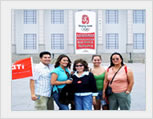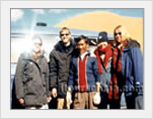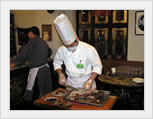
Chinese Clothing
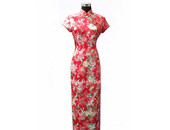 Upon talking about oriental garments, people may think of elegant Chinese garments and implicit, pretty cheongsam (Qipao) which embody national clothing culture of China for thousands of years. Color, appearance and pattern are the three essentials of Chinese traditional clothing. In ancient times, Chinese ancestors considered black as the color of God. Therefore the costume of emperor of Xia, Shang, and Zhou dynasties were all in black. Along with the development of feudal central autocracy, people turned to worship the earth; “yellow” was regarded by the traditional concept as noble. Affected by Yin, Yang and the five elements, traditional clothing used the five colors of indigo, red, black, white and yellow as orthodox colors. They were used only by upper strata of many dynasties as noble colors. The colors were subsidiary. The common folks were after and loved all the orthodox colors as well.
Upon talking about oriental garments, people may think of elegant Chinese garments and implicit, pretty cheongsam (Qipao) which embody national clothing culture of China for thousands of years. Color, appearance and pattern are the three essentials of Chinese traditional clothing. In ancient times, Chinese ancestors considered black as the color of God. Therefore the costume of emperor of Xia, Shang, and Zhou dynasties were all in black. Along with the development of feudal central autocracy, people turned to worship the earth; “yellow” was regarded by the traditional concept as noble. Affected by Yin, Yang and the five elements, traditional clothing used the five colors of indigo, red, black, white and yellow as orthodox colors. They were used only by upper strata of many dynasties as noble colors. The colors were subsidiary. The common folks were after and loved all the orthodox colors as well.
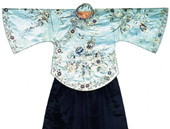 Traditional Chinese clothing appearance stresses vertical feeling and often applies drooping lines and long sleeves covering hands as well as tube-shaped skirt. Cheongsam (Qipao), is a close-fitting dress with a high neck and slit skirt The aim of the dress is to make the lady’s appearance slender. Chinese clothing likes to use patterns to express auspicious wishes. From ancient times up to now, the use of auspicious pattern is widespread on the noble silk and satin as well as folk-printed flower cloth. For instance, there are “Dragon and Phoenix Showing Auspicious”, “Flying Dragon and Dancing Phoenix”, “Nine Dragon Playing Showing Pearls”. They not only imply the worship of totem but also express the feeling of “Descendents of Dragon” and reflect people’s aspiration for nice life. Along with the development of economic globalization nowadays, the mixture of Chinese and Western clothing culture is getting momentum. Chinese clothing business is trying to keep in pace with the world and take the road of fashion with national characteristics. Chinese clothing industry puts Western-fashion elements in design, and the Chinese traditional elements are now influencing the development of international fashion at the mean time.
Traditional Chinese clothing appearance stresses vertical feeling and often applies drooping lines and long sleeves covering hands as well as tube-shaped skirt. Cheongsam (Qipao), is a close-fitting dress with a high neck and slit skirt The aim of the dress is to make the lady’s appearance slender. Chinese clothing likes to use patterns to express auspicious wishes. From ancient times up to now, the use of auspicious pattern is widespread on the noble silk and satin as well as folk-printed flower cloth. For instance, there are “Dragon and Phoenix Showing Auspicious”, “Flying Dragon and Dancing Phoenix”, “Nine Dragon Playing Showing Pearls”. They not only imply the worship of totem but also express the feeling of “Descendents of Dragon” and reflect people’s aspiration for nice life. Along with the development of economic globalization nowadays, the mixture of Chinese and Western clothing culture is getting momentum. Chinese clothing business is trying to keep in pace with the world and take the road of fashion with national characteristics. Chinese clothing industry puts Western-fashion elements in design, and the Chinese traditional elements are now influencing the development of international fashion at the mean time.
Your Question & Quick Answer*We welcome and appreciate your questions & reviews
Booking Procedures | Terms & Conditions | Payment Methods | Links | Site Map | About Us | Contact Us | Travel Agent
Copyright 2008, All rights reserved.. itourbeijing.com ,china culture, china introduction
TEL: 86-10-85711972 (Universal) 1-888-288-9328 (North America) E-mail: contact@itourbeijng.com
Home | China Tours | Beijing Tours | Tibet Tours | China Travel | Beijing Travel | Shanghai Travel
